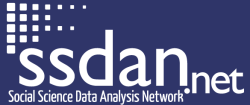Students will be able to
1. Examine a database, using Microsoft Excel to download it and later selecting the variables of study and preparing them for analysis.
2. Statistically analyze (frequency tables, in specific) a database, using IBM SPSS Statistics.
Due to the recent increase of databases that are available in the Internet for the public use, the secondary data analysis is a research method that has become more popular in Puerto Rico. Because of its advantages of realization in less time and with less money, in comparison with other research methods, and possible exemption of revision by an institutional review board, both undergraduate and graduate students should know more about this method and consider it for future research, such as papers and dissertations. To increase the interest of the students, this module is based on the variables that are included, since 2013, in the American Community Survey, which are about the computer and Internet use in the households.
1. Classroom with computers for students and a computer and projector for the professor or a classroom with desks so the students can use their personal computers and a computer and projector for the professor
2. Access to the Internet, Google Chrome, IBM SPSS Statistics, Microsoft Excel, and Word
3. Prior reading by the students of these publications, as minimum: Computer and Internet use in the United States: 2013; A compass for understanding and using American Community Survey data: What PUMS data users need to know, and Maximizing research opportunities: Secondary data analysis (see Resource list/guide and Bibliography).
